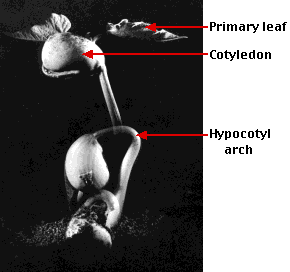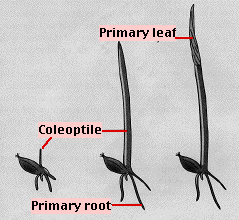Germination of Seeds
Germination is the resumption of growth of the embryo plant inside the seed.
Requirements:
- Proper temperature.
- Water.
Water is always needed to allow vigorous metabolism to begin. It is also sometimes needed to leach away a germination inhibitor within the seed. This is especially common among desert annuals. The inhibitor is often abscisic acid (ABA).
- Oxygen.
- A preceding period of dormancy (often).
The seeds of many temperate-climate angiosperms will germinate only after a prolonged period of cold. An inhibitor within the seed (probably abscisic acid - ABA) is gradually broken down at low temperatures until finally there is not enough to prevent germination when other conditions become favorable. This mechanism is of obvious survival value in preventing seeds from germinating during an unseasonably warm spell in the autumn.
- Correct photoperiod (often).

Germination in Dicots
- The primary root emerges through the seed coats while the seed is still buried in the soil.
- The hypocotyl emerges from the seed coats and pushes its way up through the soil. It is bent in a hairpin shape - the hypocotyl arch - as it grows up. The two cotyledons protect the epicotyl structures - the plumule - from mechanical damage.
- Once the hypocotyl arch emerges from the soil, it straightens out. This response is triggered by light. Both
- red light, absorbed by phytochrome and
- blue light, absorbed by cryptochrome can do the job.
- The cotyledons spread apart exposing the
- epicotyl, consisting of
- In many dicots, the cotyledons not only supply their food stores to the developing plant but also turn green and make more food by photosynthesis until they drop off.
The image (courtesy of the Pittsburgh Plate Glass Co.) is a time-lapse photograph showing three stages in the germination of a bean seed.

Germination in Monocots
When grass seeds, e.g. corn (maize) or oats (shown here), germinate
- the primary root pierces the seed (and fruit) coverings and grows down;
- the primary leaf of the plant grows up. It is protected as it pushes up through the soil by the coleoptile - a hollow, cylindrical structure.
- Once the seedling has grown above the surface, the coleoptile stops growing and
- the primary leaf pierces it.
28 March 1999

